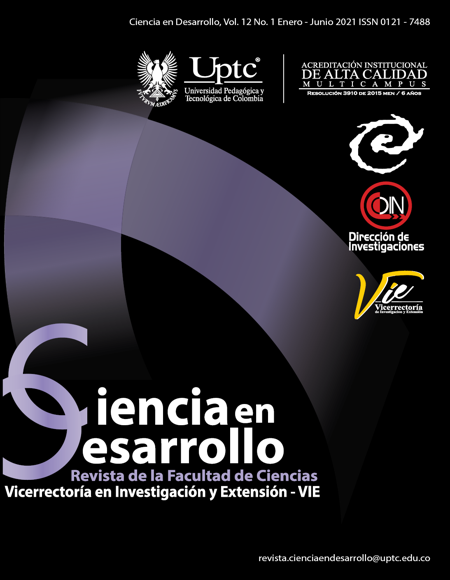Oxidación de glicerol por titania fluorada y platinizada

Resumen
En el presente trabajo se evaluó TiO2 fluorizado y platinizado en la oxidación del glicerol. La fluorización permitió incrementar el área superficial de la titania y la platinización llevó a obtener una mayor absorción en la región visible del espectro electromagnético; así, 0.5 wt.% Pt-F-TiO2 fue el mejor catalizador en la obtención del mayor rendimiento y selectividad hacia gliceraldehído (GAL). También se encontró que un contenido de 2% de Pt tiene un efecto negativo sobre la conversión de glicerol. La fluorización y la adición de platino llevaron a modificar el mecanismo de reacción y la selectividad.
Palabras clave
Glycerol; 0.5wt.% Pt-F-TiO2; 2wt.% Pt-F-TiO2; Glyceraldehyde; Dihydroxyacetone.
Citas
[1] M. Rossi, C. Della-Pina, M. Pagliaro, R. Ciriminna, P. Forni, “Greening the Construction Industry: Enhancing the Performance of Cements by Adding Bioglycerol”, Chem Sus Chem., 1, p. 809-812, 2008.
[2] R. Ciriminna, G. Palmisano, C. Della-Pina, M. Rossi, M. Pagliaro, “One-pot electrocatalytic oxidation of glycerol to DHA”, Tetrahedron Lett., 47, p. 6993-6995, 2006.
[3] J.A. Kenar, “Glycerol as a platform chemical: Sweet opportunities on the horizon?”, Lipid Technol., 19, p. 249-253, 2007.
[4] M. Bowker, C. Morton, J. Kennedy, H. Bahruji, J. Greves, W. Jones, P.R. Davies, C.P. Brookes, P. Wells, N. Dimitratos, “Hydrogen production by photoreforming of biofuels using Au, Pd and Au–Pd/TiO2 photocatalysts”. J. Catal., 310, p. 10–15, 2014.
[5] S. Demirel-Gülen, M. Lucas, P. Claus, "Liquid phase oxidation of glycerol over carbon supported gold catalysts"” Catal. Today., 102, p. 166-172, 2005.
[6] W.C. Ketchie, M. Murayama, R.J. Davis, “Selective oxidation of glycerol over carbon-supported AuPd catalysts”, J. Catal., 250, p. 264-273, 2007.
[7] M. Maicu, M.C. Hidalgo, G. Colón, J.A. Navío, “Comparative study of the photodeposition of Pt, Au and Pd on pre-sulphated TiO2 for the photocatalytic decomposition of phenol”, J. Photochem. Photobiol., A., 217, p. 275-283, 2011.
[8] D. Li, H. Haneda, S. Hishita, N. Ohashi, N.K. Labhsetwar, “Fluorine-doped TiO2 powders prepared by spray pyrolysis and their improved photocatalytic activity for decomposition of gas phase acetaldehyde”. J. Fluorine Chem., 126, p. 69-77, 2005.
[9] K. Okazaki, Y. Morikawa, S. Tanaka, K. Tanaka, M. Kohyama, “Effects of stoichiometry on electronic states of Au and Pt supported on TiO2(110)”, J. Mater. Sci. 40, p. 3075-3080, 2005.
[10] J.J. Murcia, J.R. Guarín, A.C. Cely Macías, H. Rojas, J.A. Cubillos, M.C. Hidalgo, J.A. Navío, “Methylene blue degradation over M-TiO2 photocatalysts (M= Au or Pt)”. Ciencia En Desarrollo., Vol. 8, p. 109-117, 2017.
[11] J. Yu, Q. Xiang, J. Ran, S. Mann, “One-step hydrothermal fabrication and photocatalytic activity of surface-fluorinated TiO2 hollow microspheres and tabular anatase single micro-crystals with high-energy facets”, Cryst. Eng. Commun., 12, p. 872-879, 2010.
[12] J.J. Murcia, M.C. Hidalgo, J.A. Navío, J. Araña, J.M. Doña-Rodríguez, “Study of the phenol photocatalytic degradation over TiO2 modified by sulfation, fluorination, and platinum nanoparticles photodeposition”, Ap. Catal., B., 179, p. 305–312, 2015.
[13] G. Iervolino, V. Vaiano, J.J. Murcia, L. Rizzo, G. Ventre, G. Pepe, P. Campiglia, M.C. Hidalgo, J.A. Navío, D. Sannino, “Photocatalytic hydrogen production from degradation of glucose over fluorinated and platinized TiO2 catalysts”, J. Catal., 339, p. 47-56, 2016.
[14] M.N. Chong, V. Vimonses, S. Lei, B. Jin, C. Chow, C. Saint, “Synthesis and characterisation of novel titania impregnated kaolinite nano-photocatalyst”, Micropor Mesopor Mat, 117, p. 233-242, 2009.
[15]. J. Fernández, J. Kiwi, J. Baeza, J. Freer, C. Lizama, H.D. Mansilla, “Orange II photocatalysis on immobilised TiO2: Effect of the pH and H2O2”. Ap. Catal. B, 48, p. 205-211, 2004.
[16] R. Molinari, F. Pirillo, M. Falco, V. Loddo, L. Palmisano, “Photocatalytic degradation of dyes by using a membrane reactor”, Chem Eng Process, 43, p. 1103-1114, 2004.
[17] S.P. Tandom, J.P. Gupta, “Measurement of forbidden energy gap of semiconductors by diffuse reflectance technique”, Physica Status Solidi B. 38, p. 363-367, 1970.
[18] M.S. Vohra, S. Kim, W. Choi, “Effects of surface fluorination of TiO2 on the photocatalytic degradation of tetramethylammonium”, J. Photochem. Photobiol., A., 160, p. 55-60, 2003.
[19] A. Behr, J. Eilting, K. Irawadi, J. Leschinski, F. Lindner, “Improved utilisation of renewable resources: new important derivatives of glycerol”, Green Chem., 10, p. 13–30, 2008.
[20] V. Augugliaro, H.A. Hamed, V. Loddo, A. Mele, G. Palmisano, L. Palmisano, S. Yurdakal, “Partial photocatalytic oxidation of glycerol in TiO2 water suspensions”. Catal Tod. 151, p. 21-28, 2010.
[21] D. Liang, J. Gao, J. Wang, P. Chen, Z. Hou, X. Zheng, “Selective oxidation of glycerol in a base-free aqueous solution over different sized Pt catalysts”, Catal. Commun., 10, p. 1586-1590, 2009.